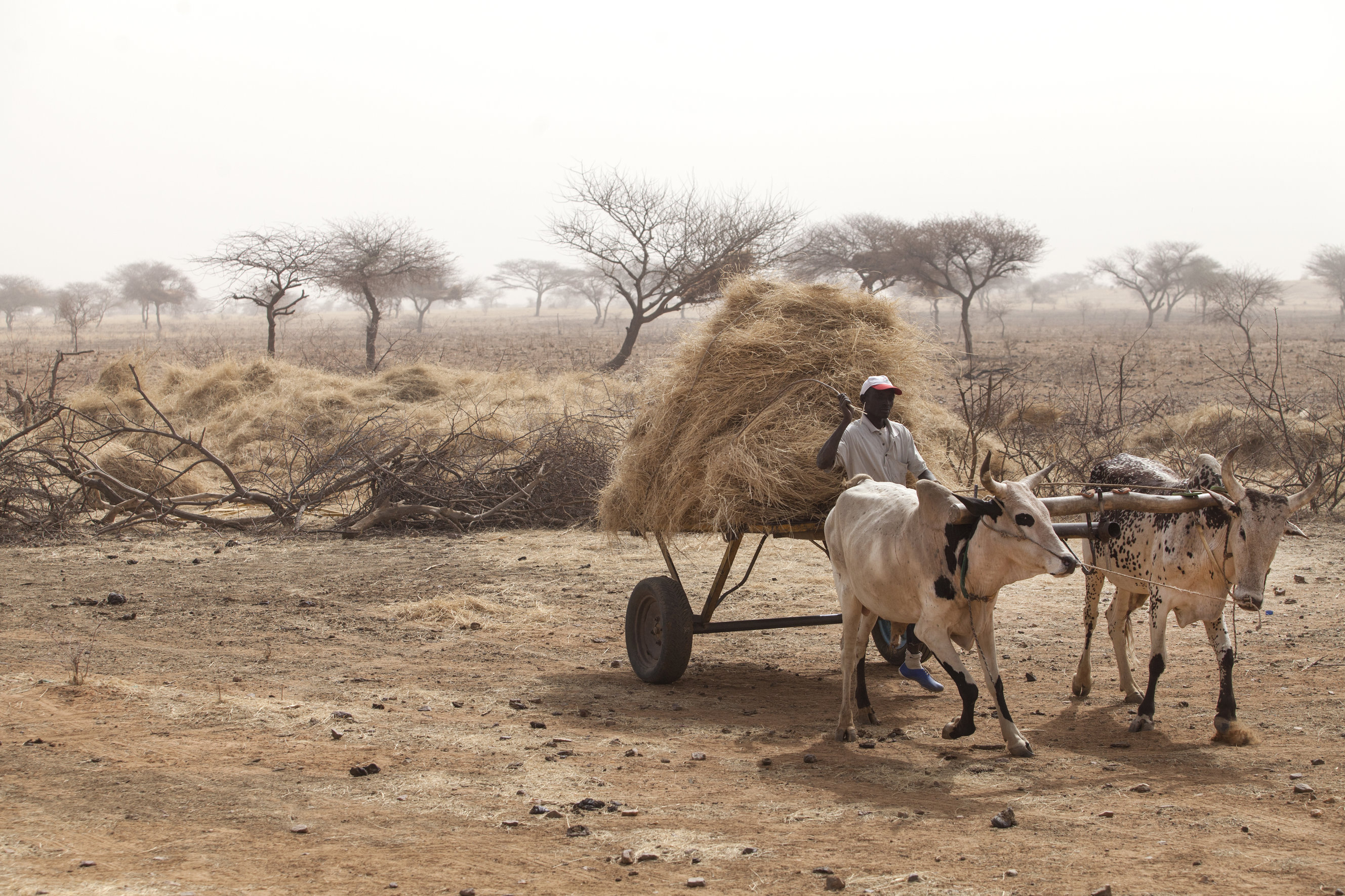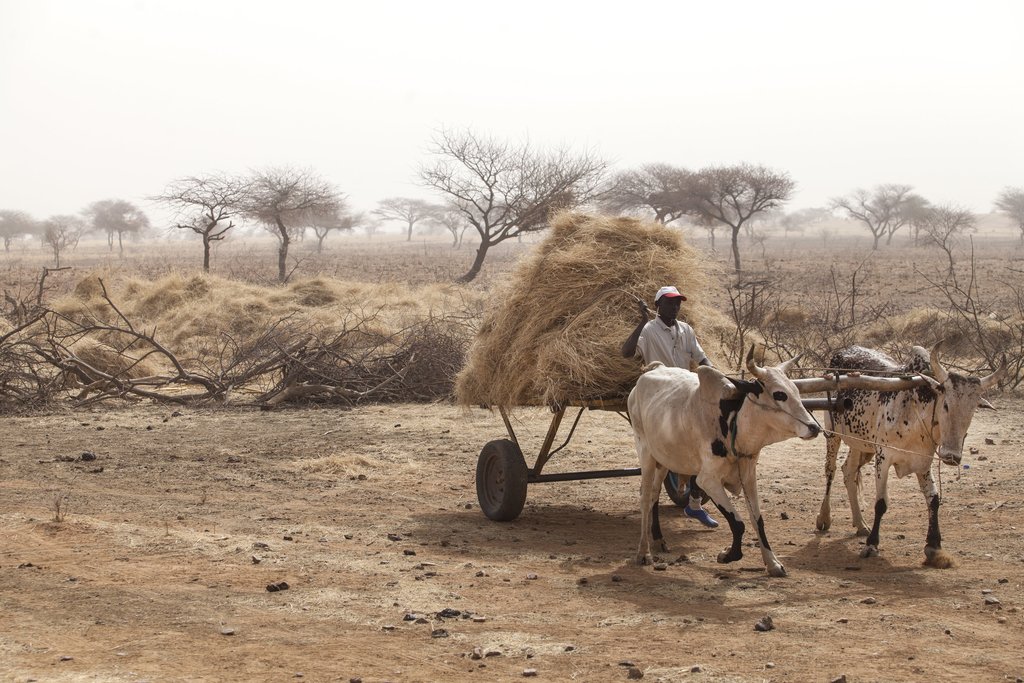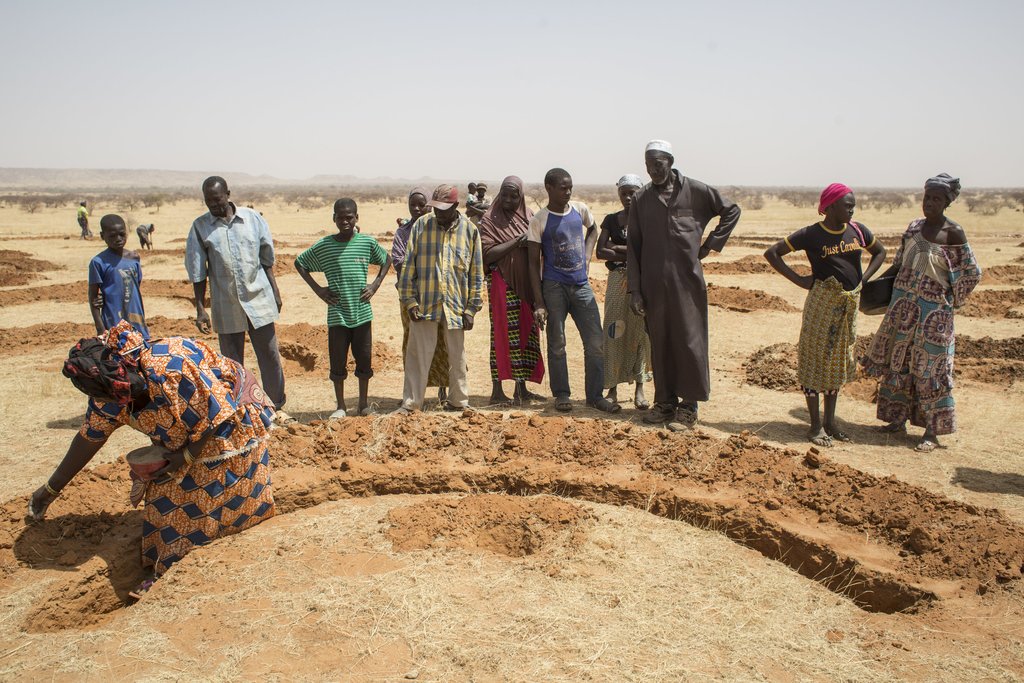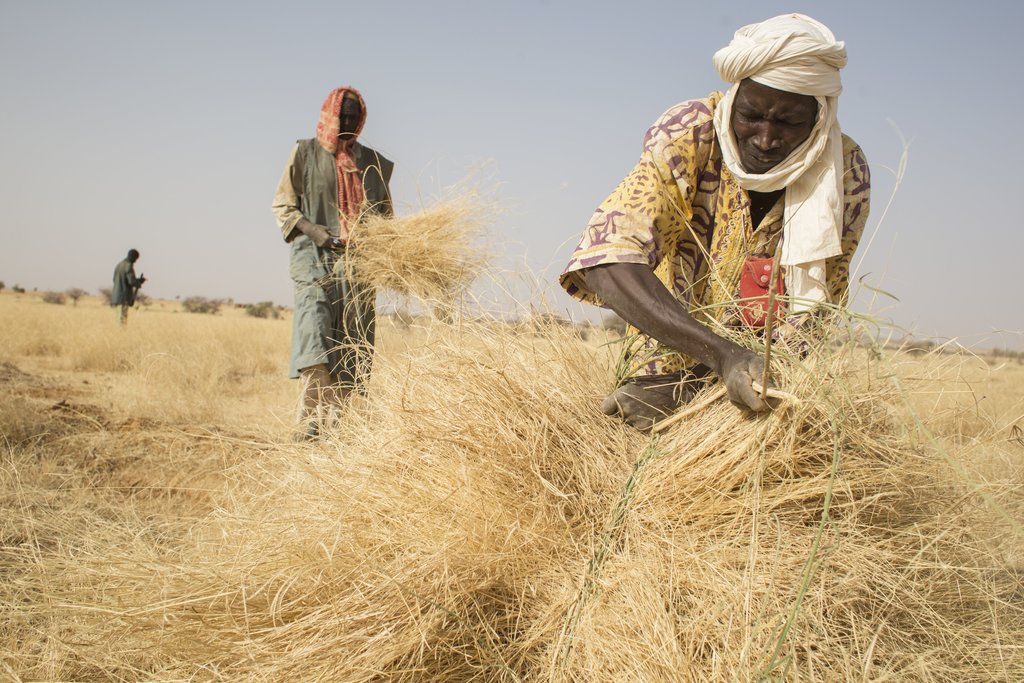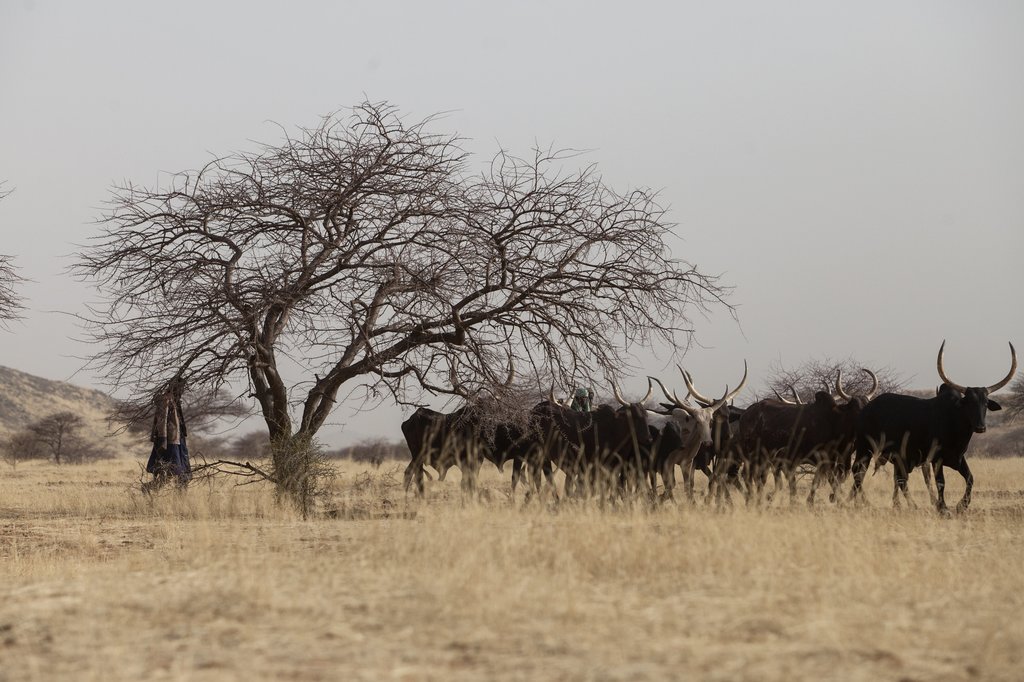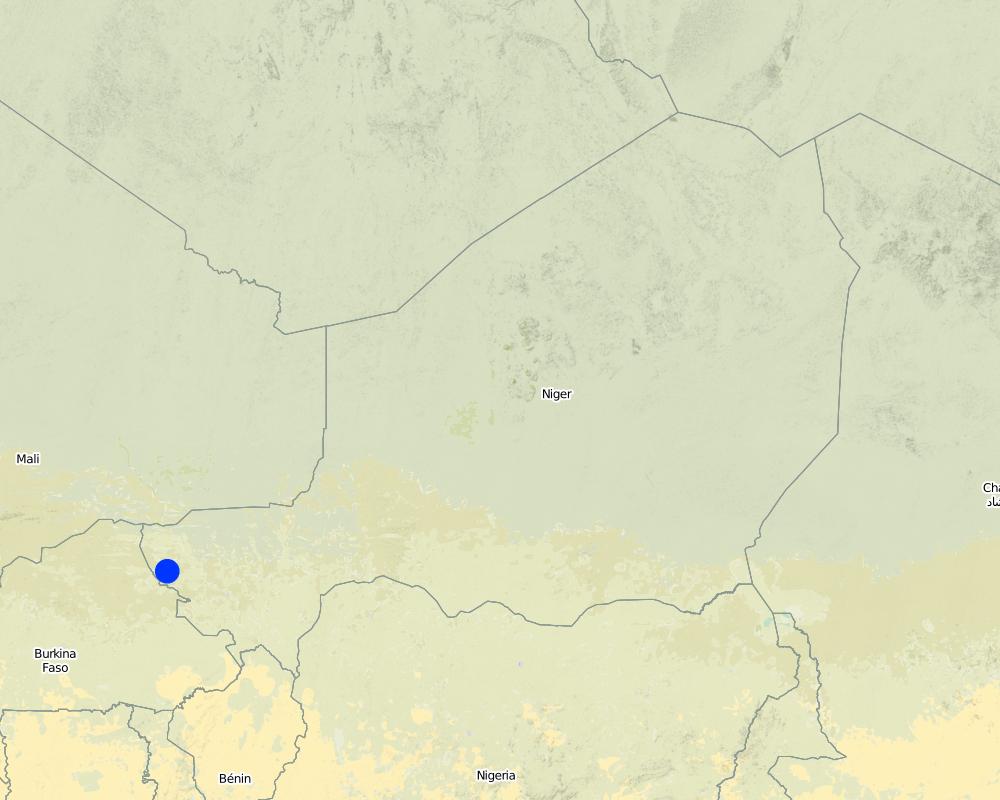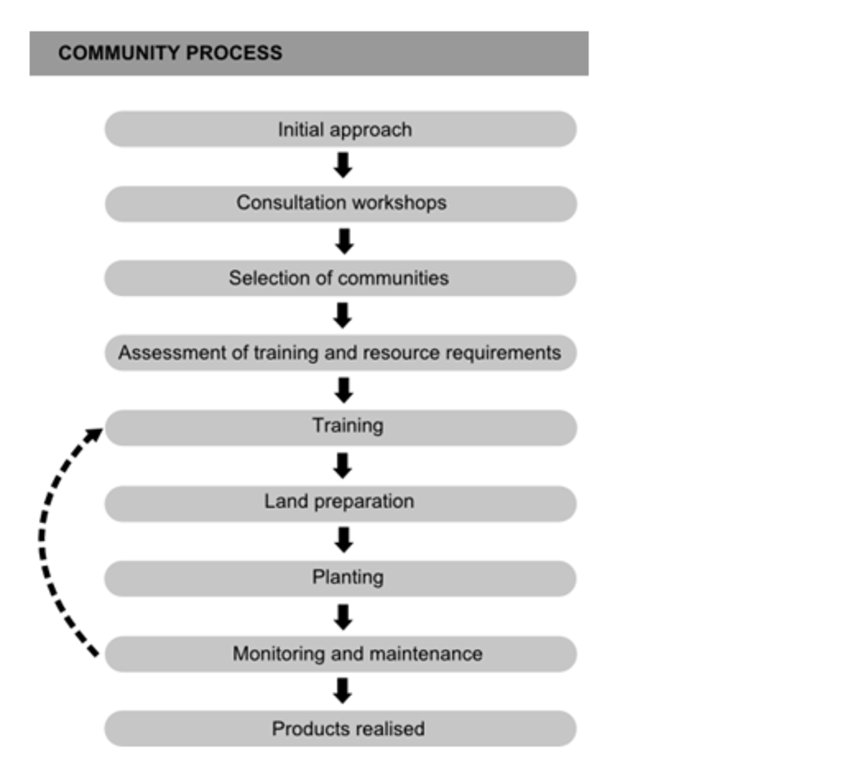Community participation in large-scale land restoration for Africa‘s Great Green Wall programme in Niger. [Нигер]
- Создание:
- Обновить:
- Составитель: Vivian Onyango
- Редактор: –
- Рецензент: Rima Mekdaschi Studer
approaches_2909 - Нигер
- Полная аннотация в формате PDF
- Полная аннотация в формате PDF для вывода на печать
- Полная аннотация в формате интернет-страницы
- Полная аннотация (неотформатированно)
- Community participation in large-scale land restoration for Africa’s Great Green Wall programme: 2 ноября 2021 г. (inactive)
- Community participation in large-scale land restoration for Africa’s Great Green Wall programme: 4 июля 2018 г. (inactive)
- Community participation in large-scale land restoration for Africa’s Great Green Wall programme : 13 мая 2018 г. (inactive)
- Community participation in large-scale land restoration for Africa’s Great Green Wall programme : 26 апреля 2018 г. (inactive)
- Community participation in large-scale land restoration for Africa‘s Great Green Wall programme in Niger.: 24 апреля 2018 г. (inactive)
- Community participation in large-scale land restoration for Africa’s Great Green Wall programme: 21 августа 2024 г. (public)
Просмотреть разделы
Развернуть все Свернуть все1. Общая информация
1.2 Контактные данные специалистов и организаций, участвующих в описании и оценке Подхода
Специалист по УЗП:
Sacande Moctar
moctar.sacande@fao.org
Forestry Policy and Resources Division (FOA)
Италия
Название проекта, содействовавшего документированию/оценке Подхода (если применимо)
FAO-Action Against DesertificationНазвание организации (-ий), содействовавших документированию/оценке Подхода (если применимо)
Food and Agriculture Organization of the United Nations (FAO) - Италия1.3 Условия, регламентирующие использование собранных ВОКАТ данных
Составитель и ответственный/-ые специалист(-ы) согласны с условиями, регламентирующими использование собранных ВОКАТ данных:
Да
2. Описание Подхода УЗП
2.1 Краткое описание Подхода
The Food and Agriculture Organization of the United Nations (FAO) has been implementing a participatory approach to implement large-scale restoration of degraded land in the Sahel, by placing rural communities at the center. In the framework of the Great Green Wall initiative, well adapted useful native species of trees, shrubs, and fodder grasses are planted in agro-sylvo-pastoral land that responds to community needs and preferences and at the same time to the ecological suitability.
2.2 Подробное описание Подхода
Подробное описание Подхода:
The approach is implemented under FAO's Action against Desertification (AAD) programme in the Great Green Wall for the Sahara and the Sahel (GGWSSI); Africa's flagship initiative to combat the effects of climate change and desertification, and address food insecurity and poverty, bringing together more than 20 African countries with international organizations, research institutes, civil society and grassroots organizations. Through the GGWSSI, the vision is a mosaic of sustainable land use practices and productive landscapes across North Africa, the Sahel and the Horn.
Community participation in the Great Green Wall Restoration is a people-centered approach to rangeland management that puts communities at the heart of restoration efforts and focusses on their needs for useful plant species such as well-adapted native trees, shrubs and fodder grasses with a high resilience to drought and preferences for restoration in support of their livelihoods. Village communities decide on lands and on diverse species that they can use for food, to feed animals, for medical care and to produce economically valuable goods for local, national and even international markets, such as gum Arabic for example. Technically, AAD support the implementation of land restoration activities through provision of necessary equipment and strengthening the technical and functional capacities of individuals, communities, and organizations in restoration techniques and sustainable land management.
The main objectives of this approach are:
a) Poverty alleviation;
b) Ending hunger;
c) Improving resilience to climate change using a landscape approach.
The restoration approach is based on a five-step model:
• Communities: needs and requirements for restoration are determined through in-depth consultations with communities.
• Research: the quality seed is made available for the propagation of economically viable, locally adapted and bio-diverse material.
• Operational procedure: ensuring efficient operational restoration processes, including land preparation and management, assisted natural regeneration and planting.
• Monitoring: evaluating the field performance of species, as well as communal activities such as maintenance and management of restored areas.
• Capacity development: develop village technicians’ capacities in forest seed collecting and nursery techniques, planting, maintenance and management of restored areas, and development of plant products, marketing, and local business management.
2.3 Фотографии, иллюстрирующие Подход
Общие замечания к фотографиям:
The photos were taken under the FAO project GCP/INT/157/EC: Action Against Desertification is an initiative of the African, Caribbean and Pacific Group of States (ACP) to promote sustainable land management and restore drylands and degraded lands in Africa, the Caribbean and the Pacific, implemented by FAO and partners with funding from the European Union in the framework of the 10th European Development Fund (EDF).
2.4 Видеоматериалы по применению Подхода
Комментарий, краткое описание:
https://www.youtube.com/watch?v=qVcMSeXZnJI
Over the next decade, 50 million people may be displaced by desertification - the result of climate change and the depletion of natural resources. Action Against Desertification, an initiative of the African, Caribbean, and Pacific Group of States is implemented by the Food and Agriculture Organization of the United Nations with the financial contribution of the European Union. It aims to restore the productivity of degraded forests and landscapes and enhance the resilience of people to climate change in 6 Great Green Wall countries in Africa as well as Haiti in the Caribbean and Fiji in the Pacific.
Дата:
02/12/2015
Место:
Rome
Автор съемки:
© FAO
Комментарий, краткое описание:
https://www.youtube.com/watch?v=prl1eaSvQCQ&feature=youtu.be
Land restoration in the Sahel is making degraded areas productive again, providing economic opportunities in a region where migration has become a tradition. Under FAO’s “Action Against Desertification” programme, these efforts are being expanded to six African countries. Land degradation around the Sahara is not yet irreversible.
Дата:
18/07/2016
Место:
Rome
Автор съемки:
© FAO
2.5 Страна/ регион/ место, где применялся Подход
Страна:
Нигер
Административная единица (Район/Область):
Tillabery, Dosso and Tahoua
Более точная привязка места:
In Niger, the GGW covers all the eight Regions of the countries. Currently FAO’s Action Against Desertification project works in three Regions including Tillabery, Dosso and Tahoua, though the approach is used and expanding to all of the remaining 5 Regions, which are also implementing the GGW restoration programme.
Комментарии:
The AAD land restoration approach has been successfully implemented with trans-boundary interventions in Niger, Burkina Faso, and Mali. For this documentation, the focus is on Tera, Niger.
Map
×2.6 Даты начала и окончания реализации Подхода
Год начала реализации:
2013
2.7 Тип Подхода
- в рамках проекта/ программы
2.8 Каковы цели/ задачи Подхода
Key elements and aim of this approach include:
• That the right species planted in the right place.
• Promote the use of quality native forest and fodder seeds for restoration.
• Ensuring that a wide range of useful plant species is used or made available for use.
• Managing natural regeneration of species and planted areas through village management committees.
• Updating a species database for gene-pool traceability, monitoring, reporting and for future uses of data and information.
2.9 Условия содействующие применению Технологии/ Технологий в рамках Подхода или затрудняющие его
Социальные/ культурные/ религиозные нормы и ценности
- содействуют
The approach is people centered and builds up on traditional management of land and traditional ecological knowledge and techniques such as half-moon for rain water harvesting that facilitates improved seedling and crop establishment.
Наличие/ доступность финансовых ресурсов и услуг
- содействуют
Individuals can use finances to buy seeds. At community land, finances maybe needed to lease land needed for production of plant varieties needed, for hiring labour to take care of seedlings.
Институциональные условия
- содействуют
Better organization at local level enhances community participation and commitment to realize the interventions at large scale/community level.
Сотрудничество/ координация действий
- содействуют
There are various levels of collaboration needed for example in establishing land, in seed selection based on desired needs and also on labour provision.
Fundamentally, collaboration is key to agreeing on desired objectives.
Нормативно-правовая база (землевладение, права на земле- и водопользование)
- содействуют
Secure access rights to land and water resources is a motivation for investing in reforestration.
Программные документы/ руководящие установки
- содействуют
national level policies can protect and ensure supply of seeds and seed varieties as well as access to natural resources such as land.
Additionally, policies such as those in support for Great Green Wall activities create an enabling environments on which these activities can be supported and take place.
Управление земельными ресурсами (принятие решений, осуществление и контроль за выполнением)
- содействуют
Similar to legal framework above.
Осведомленность в области УЗП, доступность технической поддержки
- содействуют
Knowledge around SLM contributes to maintenance and management of restored areas thus ensuring sustainability of activities. The programme has integrated existing/traditional SLM activities such as zaï/half-moon in capturing, retaining and saving water thus keeping soils moisturized and giving plants a chance to grow in an otherwise very dry environment.
Рынки (для приобретения материалов и услуг, продажи продукции) и цены
- содействуют
Market access and increasing economic capacities of communities can enable active involvement in restoration especially when plant products can earn income thus facilitating local business management.
Объем работ, доступность рабочей силы
- содействуют
Availability of labour facilitates activities such as forest seed collecting, nursery techniques, planting, maintenance and management of restored areas. Most of the work is done by women who prepare the soils and lead planting.
3. Участие и распределение ролей заинтересованных сторон
3.1 Заинтересованные стороны, участвующие в реализации Подхода и их роли
- местные землепользователи/ местные сообщества
Total project beneficiaries are 116,000 people (with over half women)
Age groups varied from 15 to 70 years.
Participants were villages including farmers, herders, traditional healers and herbalists.
Each intervention village has a village management committee set up for the GGW implementation activities. They contribute land and labour and village technicians are trained in large scale degraded land restoration techniques so that they can be self-sufficient at the end of the funding.
1. Defining needs, preferences of species and objectives for land restoration in degraded lands.
2. Trained on collection of seeds and on how to produce seedlings in village nurseries.
3.The involved communities also participated in the regular monitoring and evaluation of plots.
4. Participating in workshops including to agree on work plans
5. Communities were also source of rich traditional ecological knowledge
6. Supporting project through in-kind contributions such as labour and land
7. Representation in the steering committee
- организации местных сообществ
Each intervention village has a village management committee set up for the GGWSSI implementation activities
- Contibute land, labour and village technicians to be trained on large scale land restoration techniques geared at self-sufficiency at the end of project life.
-Managing intervention sites including products such as fodder
-Collaborating with national and local administration
- эксперты по УЗП/ сельскому хозяйству
Support to identification of land needed for restoration, seeds and management objectives of restoration.
- ученые-исследователи
National seed centres.
1. Address the availability of good quality seeds for collection
2. Ensuring genetic diversity reflecting original provences of native species.
- общественные организации
Local NGOs and CBOs.
Local NGO's were trained on land restoration activities.
NGOs were also instrumental in discussions on scaling up the approaches and policy support for mainstreaming sustainable land management .
- частный сектор
Supplies of equipment and materials needed for restoration activities.
Mainly business related to procurement of goods and services.
- местные власти
Local administration and national governments in the respective countries.
1. provide technical management and management if the operational team.
2. Mobilization of communities.
3. Part of the steering committee.
- государственные власти (отвечающие за планирование или принятие решений)
1. Ministry of Environment and Sustainable Development.
2. National Agency of the Great Green Wall.
3. National Forestry Seed Centre.
4. Local authorities (i.e. Mairies or Town halls) involved in Tillabery, Dosso and Tahoua regions.
- международные организации
Royal Botanical Garden, Kew.
Technical support; botanical knowledge and information resources, and identifying priority species for the Great Green Wall.
3.2 Участие местных землепользователей/ местных сообществ на разных стадиях реализации Подхода
| Участие местных землепользователей/ местных сообществ | Перечислите участников и опишите их вовлеченность | |
|---|---|---|
| инициирование/ мотивация | интерактивное | Communities local knowledge, needs and aspirations were the back-borne of the project. Communities were extensively consulted on species identification and prioritization based on needs including speed of return of products for the local communities, personal knowledge and inspirations. This was through questionnaires and village workshops. I bigger commitment and buy-in from the community was also a prerequisite for activities to start as they had to commit to contribute land and labour in-kind. As a matter of fact, selection of villages for restoration was based on among other things motivation and commitment by communities to participate in restoration activities. and community based structures and organization. |
| планирование | интерактивное | Extensive planning was done with communities before implementation e.g. to agree on planting time ( at onset of rains), use of traditional techniques and land scarification. |
| выполнение | интерактивное | Implementation was done actively with communities who volunteered traditional knowledge and labour to the activities. This had built on the initiation; where species were selected and prioritized, planning of activities and later labour in preparation of land, setting up nurseries and trans-planting. |
| мониторинг/ оценка | интерактивное | Monitoring and field data collection on survival and growth of seedlings were carried out by trained village technicians in collaboration with the communities and technical institutions. |
3.3 Схема реализации (если имеется)
3.4 Принятие решений по выбору Технологии/ Технологий УЗП
Укажите, кто принимал решение по выбору применяемой Технологии/ Технологий:
- все участники как часть процесса совместных действий
Поясните:
This is a local initiative that uses traditional ecological knowledge and multi-purpose plant species (of known benefits to the local communities) for restoration.
Community participation, lifestyles and preferences and a careful analysis of ecological landscapes are carefully considered and then matched to suitable interventions. This similar approach has been applied by other projects in the GGWSSI region however although has not often been formally disseminated to wider audiences.
Поясните на чём было основано принятие решений:
- анализ подробно описанного опыта и знаний по УЗП (принятие решений на основе подтвержденных фактов)
- результаты исследований
- личный опыт и мнения (незадокументированные)
4. Техническая поддержка, повышение компетенций и управление знаниями
4.1 Повышение компетенций/ обучение
Проводилось ли обучение землепользователей/ других заинтересованных лиц?
Да
Укажите, кто проходил обучение:
- землепользователи
- местный персонал/консультанты
Если существенно, укажите гендерный и возрастной состав, статус, этническую принадлежность и т.д.
100 small-scale farmers were trained in 2017, in Natural Assisted Regeneration techniques and 40 farmers were trained in forest and fodder seed collection and the production of seedlings in village nurseries and in the management of planted sites.
Тип обучения:
- курсы
Рассматриваемые темы:
Technical training was provided to villages in formal modules on how to collect quality seeds in defined seed zones. The training was provided by the national forest seed centres . The trainings were on seedling production and participatory forest management . Other areas covered included; added-value and the development of plant products (non-timber forest products), marketing and local business management to support income generation.
Комментарии:
Apart from the restoration technical areas covered above, additional areas of training included; improving adult literacy, family health and nutritional standards. This was done together with specialized rural sector developers.
4.2 Консультационные услуги
Есть ли у землепользователей возможность получать консультации?
Да
Укажите, где именно оказываются консультационные услуги:
- на полях землепользователей
- в постоянно функционирующих центрах
- workshops
Описание/ комментарий:
To re-introduce plant for large-scale restoration, effective use of seeds of wild species demands sufficient biological and technical knowledge on a big number of species to allow for collection, storage and germination of seeds and establishment of seedlings. In this approach therefore, the technical know-how of RBG Kew and related partnership with forest seed centres that allowed for collection of quality seeds.
4.3 Институциональная (организационная) поддержка
В ходе реализации Подхода были ли организованы новые институциональные структуры или поддержаны уже существующие?
- да, существенно
Укажите уровень, на котором структуры были укреплены или вновь созданы:
- местные
- региональный
- национальный
Опишите организацию, функции и ответственность, членство и т.д.
Institutions: National government; NGOs, CBOs,
Support to the national government who is the national agency for the GGW is the entry point. Through them ad based on national objectives, the project moves to a decentralized level. At the national level, capacities have been improved on monitoring and evaluation techniques; seed identification and selection and handling.
Local level: these are the implementing partners and do work on the ground. Their capacities have been improved on seed selection and restoration techniques and on data collection
Regional level: more collaboration, coordination and knowledge sharing on the GGW initiatives as well as peer to peer learning.
Укажите тип поддержки:
- финансовая
- повышение компетенций/ обучение
- оборудование
Подробнее:
Equipment: mainly for land preparation for planting and non-timber forest processing.
4.4 Мониторинг и оценка
Являются ли мониторинг и оценка частью Подхода?
Да
Комментарии:
Regular monitoring is carried out by village communities involved in the restoration exercise. The activities include assessing seedling survival and growth and planted surface areas.
Если да, будет ли данный документ использоваться для мониторинга и оценки?
Нет
4.5 Научные исследования
Были ли научные исследования частью Подхода?
Да
Укажите темы исследований:
- социология
- экономика / маркетинг
- экология
Напишите подробнее и назовите тех, кто выполнял исследования:
Through a questionnaire, communities define their needs and preferences of species, the objectives of land restoration in their available agro-sylvo-pastoral degraded lands. Results of this consultation are fed back to them after analyses by the project team (researchers, plant expertise, seed centres) for the feasibility, suitability and availability of the requested species. This allows commonly to agree on interventions, priorities and implementation plans with roles and responsibility from the communities as well as from the technical teams.
1. Sociology: prior research was done on social diversity of village communities on areas such as gender, age, profession among others to decide on village selections but also ensure required balance.
2. Economics/marketing: This was multi-faceted on one hand looking at community economic needs and priorities and also on how to value addition to non-timber forest products. The plant-use data received from respondents were classified according to the Economic Botany Data Collection.
These helped in deciding and prioritizing species according to community needs.
3. Ecology: GGW initiative is typically for drylands with challenges such as moisture retention. Thus the ecology of the place was studied to identify suitable plant species that would thrive under these conditions of course in combination with traditional technologies that have been developed to overcome the moisture deficits.
The botany of selected species was further examined in laboratories to first of all check their suitability to dryland environments and thereafter to ensure good quality seeds are used including ensuring genetic diversity
5. Финансирование и внешняя материальная поддержка
5.1 Годовой бюджет мероприятий по УЗП в рамках Подхода
Если точный годовой бюжет неизвестен, укажите примерный диапазон затрат:
- 100 000-1 000 000
Комментарий (например, основные источники финансирования/ ключевые доноры):
Action Against Desertification is implemented by FAO and partners with funding from the European Union in the framework of the 10th European Development Fund (EDF). The GGWI under AAD in Niger is funded up to around 1.5m USD for the four years of the project.
5.2 Финансирование и внешняя материальная поддержка, предоставляемая землепользователям
Предоставлялась ли землепользователям финансовая/ материальная поддержка для применения Технологии /Технологий?
Да
Если да, укажите тип(-ы) поддержки, кто ее предоставил и условия предоставления:
Finances are needed for purchasing equipment, seeds were also provided, seed testing to establish the desired type/species.
5.3 Субсидии на отдельные затраты (включая оплату труда)
- труд
| В какой степени | Опишите субсидии подробнее |
|---|---|
| профинансированы частично | Local communities shared some tasks such as during planting period the project provided lunch. |
- оборудование
| Укажите, какие ресурсы были субсидированы | В какой степени | Опишите субсидии подробнее |
|---|---|---|
| техника | профинансированы частично | Provided such as arable tools, carts for transportation. |
| инвентарь/ инструменты | профинансированы частично | Arable tools for planting. |
- сельскохозяйственные
| Укажите, какие ресурсы были субсидированы | В какой степени | Опишите субсидии подробнее |
|---|---|---|
| семена | профинансированы частично | Training was provided on a collection of native forest seeds that were then bought from them (communities thus earning an income for communities). |
| Organic manure | Training to do and collect composts. | |
- строительные материалы
| Укажите, какие ресурсы были субсидированы | В какой степени | Опишите субсидии подробнее |
|---|---|---|
| камень | профинансированы частично | For storage facilities. |
Если труд землепользователя был существенным вкладом, укажите, был ли этот вклад:
- в обмен на другие материальные ресурсы
Комментарии:
In partnership with WFP there was collaboration on food for assets and incentives from the project such as trainings on preparation of vegetable gardens..
5.4 Кредитование
Предоставлялись ли в рамках Подхода кредиты на мероприятия УЗП?
Нет
5.5 Другие методы или инструменты стимулирования
Использовались ли другие методы или инструменты стимулирования для продвижения Технологий УЗП?
Да
Если да, поясните:
Functional capacity building village communities for example in management of restoration sites and development of community forest products
6. Анализ влияния и заключительные положения
6.1 Влияние Подхода
Сумел ли Подход расширить возможности местных землепользователей, повысить участие заинтересованных сторон?
- Нет
- Да, немного
- Да, умеренно
- Да, существенно
The project supports the communities to improve productivity of their land in direct consultation with them while benefiting from trainings with changes recorded in diversity of biomass in community plots and lands.
Сумел ли Подход дать возможность принимать решения на основе подтвержденных фактов?
- Нет
- Да, немного
- Да, умеренно
- Да, существенно
Substantial improvement is already recorded on state of land in the last 2 years.
Сумел ли Подход помочь землепользователям внедрить и поддерживать технологии УЗП?
- Нет
- Да, немного
- Да, умеренно
- Да, существенно
Trainings were provided on various aspects such as seed selection and collection.
Сумел ли Подход улучшить согласованность действий и повысить рентабельность применения практик УЗП:
- Нет
- Да, немного
- Да, умеренно
- Да, существенно
The project is not funding all aspects yet building sustainability through the direct capacity development and participation by communities.
Сумел ли Подход мобилизовать/ расширить доступ к финансовым ресурсам для применения практик УЗП?
- Нет
- Да, немного
- Да, умеренно
- Да, существенно
1. Village technicians have been used by other projects in the area in SLM and also by the government while getting remuneration. 2. Communities are able to sell native restoration seeds to other projects in the region and to the government.
Сумел ли Подход расширить знания и возможности землепользователей в применении практик УЗП?
- Нет
- Да, немного
- Да, умеренно
- Да, существенно
Through trainings and capacity development e.g. on large-scale land preparation for planting and seed selection.
Сумел ли Подход расширить знания и возможности других заинтересованных сторон?
- Нет
- Да, немного
- Да, умеренно
- Да, существенно
1. Governments; training of technicians including on specialized tools, training on monitoring and evaluation of SLM and restoration impacts. 2. CBOs and local administrations. regional organizations such as CILSS-Agryhmet were also trained on the above.
Сумел ли Подход укрепить сотрудничество между заинтересоваными сторонами/ выстроить механизмы сотрудничества?
- Нет
- Да, немного
- Да, умеренно
- Да, существенно
The village technicians and trained seed collectors are now organized in a regional union for restoration seed supply.
Сумел ли Подход снизить остроту конфликтов?
- Нет
- Да, немного
- Да, умеренно
- Да, существенно
With the increasing of fodder production, pressures on other grazing areas have gone slightly down.
Disadvantaged groups not present at village level.
Сумел ли Подход содействать гендерному равенству и расширить права и возможности женщин и девочек?
- Нет
- Да, немного
- Да, умеренно
- Да, существенно
Yes; gender equality is taken into consideration such as women representative in each village management community.
Сумел ли Подход стимулировать молодежь/ будущее поколение землепользователей заниматься УЗП?
- Нет
- Да, немного
- Да, умеренно
- Да, существенно
As income is coming in from restoration activities, it has been encouraging young people to consider SLM as in income generating opportunity.
Сумел ли Подход разрешить правовые проблемы землевладения/ землепользования, препятствующие использованию технологий УЗП?
- Нет
- Да, немного
- Да, умеренно
- Да, существенно
Communities now see more value in restoring degraded land previously neglected and there is tenure agreements with local administration. Land tenure had been insecure for local communities but now rights of access and use have been delivered by local administrations to local communities guaranteeing that restoration areas belong to communities thus ensuring sustainability also as a community see ownership of the investments.
Сумел ли Подход способствовать улучшению продовольственой безопасности/ качества питания?
- Нет
- Да, немного
- Да, умеренно
- Да, существенно
1. Farming in restored areas allows for more crop production. 2. Fodder production is feeding livestock improving production of milk and meat.
Сумел ли Подход расширить доступ к рынкам?
- Нет
- Да, немного
- Да, умеренно
- Да, существенно
1. Seeds and fodder are being sold by local communities to other projects, governments and communities.
Сумел ли Подход улучшить санитарные условия и доступ к водоснабжению?
- Нет
- Да, немного
- Да, умеренно
- Да, существенно
Not within scope.
Сумел ли Подход привести к более эффективному использованию электроэнергии/ возобновляемых источников энергии?
- Нет
- Да, немного
- Да, умеренно
- Да, существенно
Out of scope.
Сумел ли Подход улучшить способность землепользователей адаптироваться к изменениям климата и смягчать последствия катастрофических погодных явлений?
- Нет
- Да, немного
- Да, умеренно
- Да, существенно
The project aim is to increase resilience of natural capital and people living in drylands while being able to adapt to climate change.
Сумел ли Подход привести к созданию новых рабочих мест/ к расширению возможностей получения дохода?
- Нет
- Да, немного
- Да, умеренно
- Да, существенно
In seed sales, crop production, income earning from employment of technicians.
6.2 Основные причины, побуждающие землепользователей внедрять УЗП
- рост продуктивности
Increased land productivity from restored land.
- рост прибыли (доходности) и рентабельности
Improved yields and harvest.
- снижение деградации земель
Restored land provide more opportunities to land users.
- престиж, общественное давление/ солидарность
Restoration of agro-sylvo-pastoral systems promoted cohesion across different user groups and provided benefits.
- причастность к движению/ проекту/ группе/ сети
Desire to be part of community based organization and through these, management of restored lands is also possible.
- экологическая сознательность
Improved biodiversity, wildlife and link to community cultures and lifestyles was a motivator.
- традиции и верования, нравственные ценности
Linked to environmental above; need to protect and preserve wildlife and biodiversity.
- приобретение знаний и опыта в области УЗП
Project provided technical capacity development such as water harvesting and rice species to plant in right places motivated communities to participate.
- снижение остроты конфликтов
Increasing biomass in agro-sylvo-pastoral systems reduced conflicts between pastoralists and farmers.
6.3 Долгосрочная устойчивость мероприятий в рамках Подхода
Могут ли землепользователи самостоятельно (без внешней поддержки) продолжать применение того, что было реализовано в рамках Подхода?
- да
Если да, опишите как:
The capacity being developed should help farmers continue without external intervention e.g. training in collecting planting material, planting technique and in managing the plot enable continuity and the capacities developed stay within the community examples; the trained village technicians.
6.4 Сильные стороны/ преимущества Подхода
| Сильные стороны/ преимущества/ возможности по мнению землепользователей |
|---|
| Builds on existing knowledge such as the use of zhai and pit planting. |
| Income generation e.g. from selling of seeds to governments and other land users. |
| Helping achieve communities specifics objectives such as increasing tree cover. |
| Сильные стороны/ преимущества/ возможности по мнению составителя или других ключевых специалистов |
|---|
| The consultation process and the mutual trust built over time, which make people buy-in the programme and feel the ownership of the activities on the ground. |
| The technical and scientific feedback answers to priorities and preoccupation of land users in terms of restoration objectives. |
| The involvement of people in monitoring and management of their planted sites as they contribute their lands and labour. |
6.5 Слабые стороны/ недостатки Подхода и пути их преодоления
| Слабые стороны/ недостатки/ риски по мнению землепользователей | Возможные пути их преодоления/снижения? |
|---|---|
| Inability to adequately influence donor plans. | Frequent consultations. |
| Слабые стороны/ недостатки/ риски по мнению составителя или ответственных специалистов | Возможные пути их преодоления/снижения? |
|---|---|
| Inability to address all the needs of the beneficiaries. Such as demand for water supply in dry seasons restoration while project focusses on rainfed restoration. | Increased dialogue on interventions across sectors such as with donors for more systematic and integrated approach. |
| Lack of flexibility in implementation to consider some of the upcoming demands of communities. |
7. Справочные материалы и ссылки
7.1 Методы сбора/источники информации
- выезды на места, полевые обследования
7.2 Ссылки на опубликованные материалы
Название, автор, год публикации, ISBN:
FAO. 2015. Global guidelines for the restoration of degraded forests and landscapes in drylands: building resilience and benefitting livelihoods. Forestry Paper No. 175. Rome, Food and Agriculture Organization of the United Nations.
Где опубликовано? Стоимость?
UN-FAO
Название, автор, год публикации, ISBN:
Community participation at the heart of Africa’s Great Green Wall Restoration model. Authors: M. Sacande, N. Berahmouni and S. Hargreaves. In Unasylva. Volume 66 2015/3
Где опубликовано? Стоимость?
UN-FAO
7.3 Ссылки на материалы, доступные онлайн
Название/ описание:
Action Against Desertification (FAO)
Адрес в сети Интернет:
http://www.fao.org/in-action/action-against-desertification/en/
Название/ описание:
Building Africa’s Great Green Wall: Restoring degraded drylands for stronger and more resilient communities
Адрес в сети Интернет:
http://www.fao.org/3/a-i6476e.pdf
Название/ описание:
Forest and Landscape Restoration Approach
Адрес в сети Интернет:
http://www.fao.org/3/a-i5212e.pdf
Ссылки и модули
Развернуть все Свернуть всеСсылки
Нет ссылок
Модули
Нет модулей


